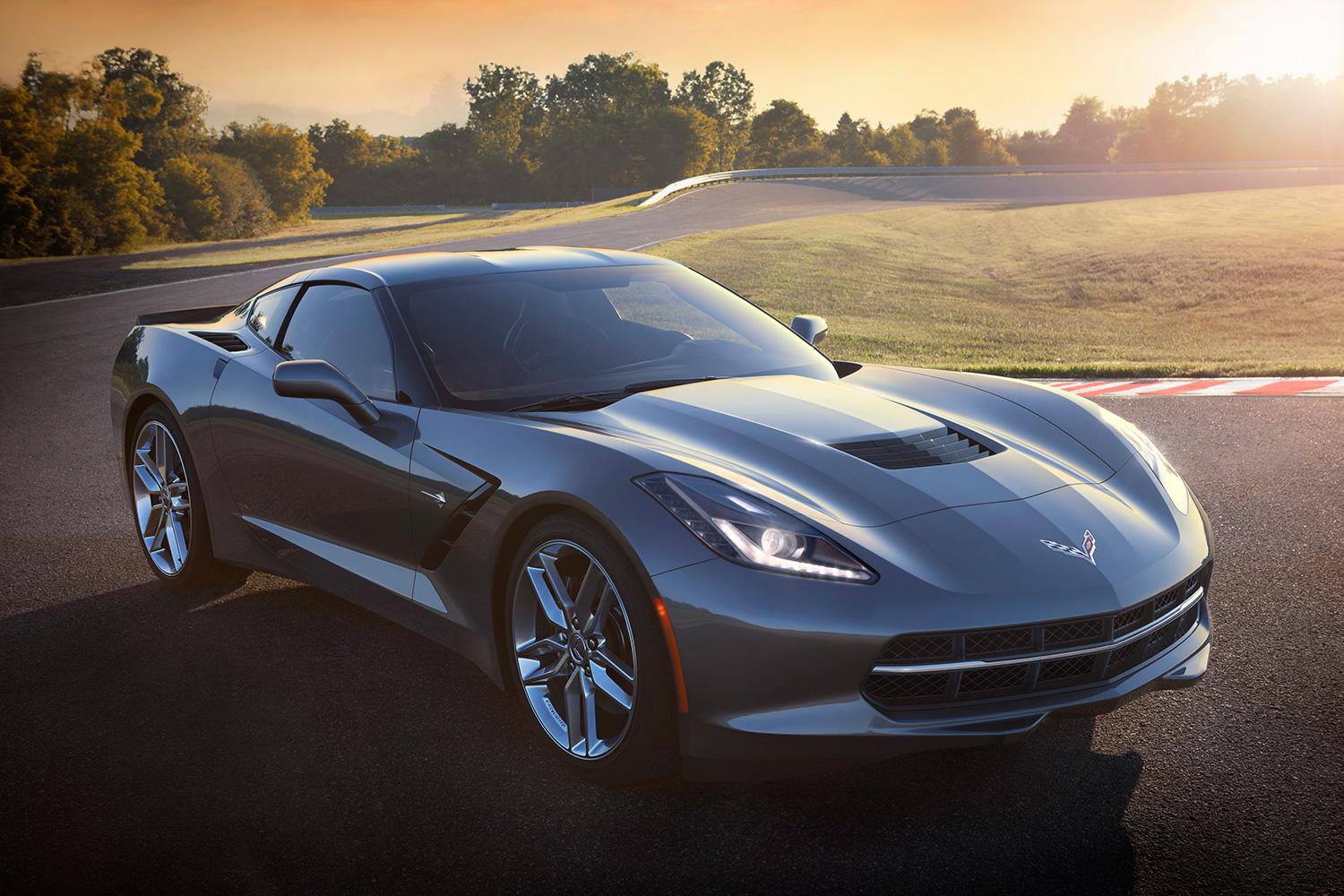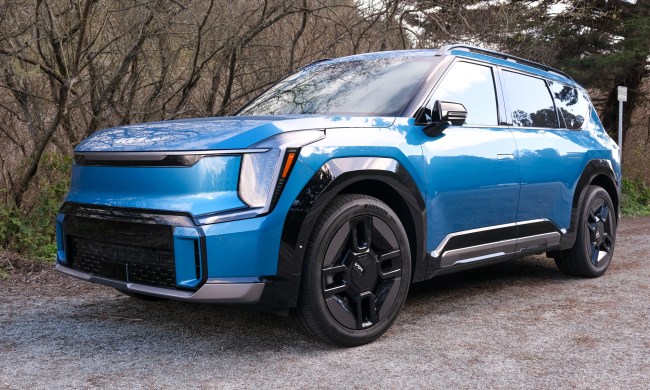
With the 2014 Chevy Corvette Stingray slated to hit dealerships early next year, there’s a good amount of buzz brewing over its arrival. Not only will the newest ‘Vette sport a heart-pounding V8, capable of generating 455 horsepower and 460 pound-feet of torque, along with a modest $52,000 price tag, but when equipped with a seven-speed manual transmission, Chevy’s claims that the Stingray will achieve up to 30 miles per gallon on the highway.
With jaw dropped firmly on the floor, I jumped on the horn with Chevrolet’s Bala Murthy, lead engineer for energy integration and Roger Clark, senior manager energy center to find out how the normally thirsty Corvette’s fuel-saving sorcery was accomplished.
… the mandate… was to achieve class-leading fuel economy without compromising on any of the performance attributes Corvette represents.
The latest version of the Corvette has already gathered a lot of positive reaction. Now we hear the seven-speed manual is able to get up to 30 mpg on the highway. How were you guys able to achieve that?
Roger Clark: We wanted to improve fuel economy while trying to match its heritage and history, so we had to focus on some of the fundamentals: things like tire rolling resistance, thinks like electric power steering. But the challenge is trying to have those systems that are really low in losses still provide the on-center feel [of the steering] and the responsiveness of a Corvette. We had two initiatives: tires, we greatly improved tire rolling resistance but we also went to electric power steering and both of those provided huge challenges in terms of keeping the Corvette’s performance level
What were some of the challenges as far as getting the feel of the electric steering just right over the previous hydraulic system?
Bala Murthy: Well basically the rack EPS (Electric Power Steering) is a new system for Corvette. We have a lot of familiarity with the hydraulic system but the challenge was to keep the EPS behaving like and providing the same level of performance as the previous hydraulic power steering system. In that regard we have achieved our target and probably set a benchmark on that level.
So this is the first Corvette to feature EPS?
Murthy: Yes.
As far as fuel economy is concerned, are there any specific technologies used in the Stingray that haven’t been featured before? And how did those technologies contribute toward fuel economy?
Murthy: We do have one neat feature in this vehicle which is Active Fuel Management. Basically we’re able to cut out the four-cylinders [of the engine] when Corvette is in Eco mode, which provides better fuel economy during highway cruising.
How exactly does Active Fuel Management work?
Murthy: The Stingray has a V8 engine consisting of eight cylinders. So what AFM does is cut out half of those when we don’t need them activated and the engine is good enough to provide the required power to cruise at that speed; we don’t need the other four cylinders to work and we save quite a bit of fuel consumption that way.
Clark: And when AFM is activated all the valves are closed so the other four cylinders that are not firing are just like air springs, there is a little bit of loss but very little loss from those cylinders, so it’s essentially running on four cylinders out of the eight.
Is this typically taking place at higher speeds?
Clark: It’s really neat because the Corvette is a vehicle with better tires and can remain in that four cylinder mode at very high speeds; up to 60 mph.

So at speeds of up to 60 miles you can remain in AFM mode without even engaging the V8 engine’s other four cylinders?
Clark: No, even faster, it really depends on a number of factors like wind grade, etc.
Murthy: We’re trying to average here so we could say anywhere between 60 and 70 miles.
Is AFM operated autonomously or is it driver controlled?
Murthy: It is automatic, you don’t even feel the transition out of AFM mode, but it happens in the manual transmission vehicle only if you press the eco button.
So the eco button has to be engaged for it to become active, otherwise it’s seamless and self-controlled?
Clark: Correct. Another interesting thing to mention is that this feature has been in our Silverado pickup for some time and this new gen-five version of the V8 is also in all of our pickup trucks as well and we use that [AFM] feature extensively to improve fuel economy.
And is AFM all taking place in real-time?
Clark: Absolutely in real time; it’s calculating how much load is needed and any time you drop below a certain threshold it knows to enter AFM mode. That switch can occur instantly, and within less than one cylinder event can close those valves off and keep them closed. So it’s constantly checking for that. Because we’ve also employed electronic throttle control, the throttle is constantly being monitored. And based on the demand from the pedal and vehicle speed, it’s monitoring all those variables instantaneously.
I think it’s safe to assume nobody wants to drive around in a sterilized Stingray so is there a noticeable drop off in power when in eco mode and AFM is engaged, will drivers be able feel the difference?
Murthy: You won’t see any performance differences at all in eco mode. When you accelerate the engine automatically gives the power that you need, only in situations like cruising where you’re not demanding that much torque will eco mode become active. When you’re passing and performing other maneuvers that require more from the engine, it’ll be on hand immediately.

As much as fancy tech plays a role in increasing fuel economy, use of lightweight materials, while less glamorous, also play an important role. Can you elaborate on specific lightweight materials the Stingray employs to help it achieve that 30 mpg figure?
Murthy: I can’t speak to each and every part but overall the Corvette is aluminum intensive as you know, and we also engaged a lot of carbon fiber composite material in this vehicle to save mass. And in order to keep the vehicle’s mass down it was necessary for Corvette to do that.
Was there anything during the development stages of the Corvette Stingray that you guys absolutely loved that got left on the cutting room floor?
Clark: I don’t think there was anything. We got virtually everything we needed in the Stingray and we’re absolutely delighted with the results to be honest.
… one neat feature… is Active Fuel Management. Basically we’re able to cut out the four-cylinders [of the engine] when Corvette is in Eco mode…
We’re obviously talking about a sports car here so how much of a factor was fuel economy really from the get go?
Clark: Right from the start, fuel-economy was an objective of the program and it was just part of the whole plan the whole time.
Murthy: Right from the beginning, the mandate given to us was to achieve class-leading fuel economy without compromising on any of the performance attributes Corvette represents.
Clark: And that’s what really led us to technologies like AFM and direct injection with the new gen-five V8.
We’re talking a lot about complex technologies here that help maximize fuel economy, but you guys mentioned tires. How do the Stingrays’ tires help with fuel economy?
Murthy: Well sportscar tires typically have a higher rolling resistance because of the increased stopping distances required as well as the increased strain placed on the tires during handling maneuvers. But that’s not to say we can’t have a low rolling resistance without compromising on performance. That’s what we aimed to achieve with Corvette’s rolling resistance. We set a goal so as not to compromise [stopping distance] and actually managed to improve it.

You spoke of the Gen 5 engine and how efficient it was but what specifically does it do to allow optimal fuel economy?
Clark: The key is direct-injection, it’s critical because that puts the fuel directly into the cylinder and it cools the cylinder when it’s firing. So what happens is we are able to go to a higher compression ratio on the fuels that we use; Corvette does recommend premium fuel, but even with premium fuel and the direct injection technology you can go to higher compression and you get more power but also more efficiency simultaneously. That’s probably the most important technology but across the board there were efforts to reduce friction in the engine and to improve its overall performance.
So the increase in compression ratio and the frequency at which the engine is able to do so allows the car to run in AFM more often?
Clark: Absolutely, so when you’re in eco mode you can engage the four cylinder operation more often, and that increases engine efficiency. And to Bala’s point earlier, it doesn’t take away from the peak power because when needed it reverts back to the full eight cylinders with the full compression and the full performance level; so you really get the best of both worlds.
I imagine Corvettes of the past served as a template during development but were there any other sportscars that served as a waypoint when it came to fuel economy?
Murthy: Well we do our benchmarking against the competition that is definitely true, we do that do keep ourselves in the competitive arena. At the same time it gives us the impetus and momentum to beat the segment when we come up with a new vehicle. But Porsche [the 911] is one that comes to mind.
Chevrolet has yet to release official fuel economy numbers for the automatic transmission but if I promise not to tell a soul – you can tell me, right?
Clark: Haha, unfortunately, we can’t at this time.

Well you can’t fault me for trying, right? Will we ever reach parity between automatic and manual transmission fuel economy numbers?
Clark: Absolutely, we’ve been closing the gap and that’s part of what has been happening with the new automatic transmissions. We’re locking up the torque convert more, that’s one of the key technologies, and with the automatic shifting it can detect and keep you in that AFM more often, which is also an advantage. So yeah, the gap is closing significantly. Of course the manual will always offer a level of control that you can’t get in an automatic.
Power and performance has always been the Corvette’s MO, so the fact that we are sitting here talking extensively about fuel economy is really a sign of the times. Is it safe to say that the Corvette’s image is evolving?
Murthy: Overall I think the Corvette is all about efficiency: the efficiency for performance, the efficiency for fuel economy – that’s what this vehicle stands for. And in order to that we had to take a systems level approach. You can tinker with individual components but they all have to work together, even something as small as using LED tail lamps to reduce the 12-volt loads on the system instead of the previous incandescent lamps, the Stingray is all about efficiency.










